Open space design is currently undergoing a reorientation: while evaluation criteria such as functionality, materiality, feasibility, quality and aesthetics have so far been geared exclusively to people, animals and plants are increasingly being included in the design process and nature conservation measures are not only understood as negative restrictions. Concepts and methods like ‘Habitectures’ (MacKinnon 2014) and 'Animal Aided Design' (Weisser/Hauck, 2017) show how animals can be creatively integrated into the planning process and how their ecosystem services can be taken into account. The first step in implementing the design is to collect information about the occurrence, behavior and needs of the living beings to be integrated, in order to create the basis for the integration into the design process. The promotion of biodiversity is based on the fact that all life forms have a fundamental right to exist, but in the long term it is also essential for the human species. In addition to knowledge or labor (human capital) or physical capital (e.g. machinery, production facilities), the economy also speaks of natural capital, i.e. the economic value of a landscape area, of which biodiversity is a central component. As part of teaching units, we analyzed two campuses of the University of Applied Sciences and Arts FHNW and designed different multi-species infrastructures and furnishings.
INTERSPECIES OUTDOOR FURNITURE
How can street furniture be designed to create contact zones for humans, animals and plants, and thus promote biodiversity?
Situation and ecological challenge
Urban outdoor furniture is usually designed to meet human's needs, such as sitting while waiting, relaxation, socializing, waste disposal and the like. They usually consist of uniformly designed elements that are combined according to the requirements of the respective situation.
Key Concepts
Apart from the greening with plants – to create a more natural atmosphere, provide shade and lower the temperature by plant transpiration – hardly any non-human creatures are normally included in the urban outdoor furniture design process. This is where Interspecies Platforms come into play to meet the needs of animals and plants in urban spaces. In collaboration with the Bachelor's degree program in Interior Architecture and Scenography concepts were developed and teaching units conducted at the Basel University of Art and Design (HGK). They were intended to sensitize students to the topics of biodiversity and interspecies cohabitation, explore what ecological contributions can be made in the disciplines of art and design and how the topic can be made tangible for the public.
A more detailed description of the concepts, teaching units and implemented prototypes are presented in the publication 'Mitwelten. Media-ecological Design Strategies for Improving Peri Urban Biodiversity'. (Coming soon!)
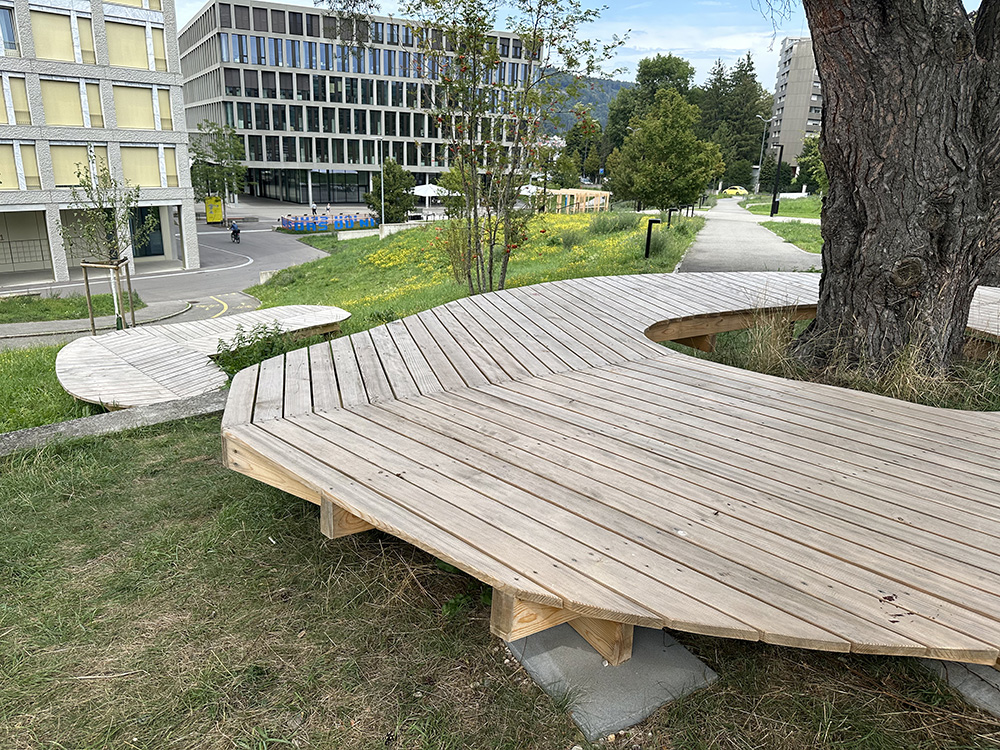
Design interventions by HGK students on the FHNW campus in Brugg-Windisch during the semester project ‘SociaLandscapes’ (2023).
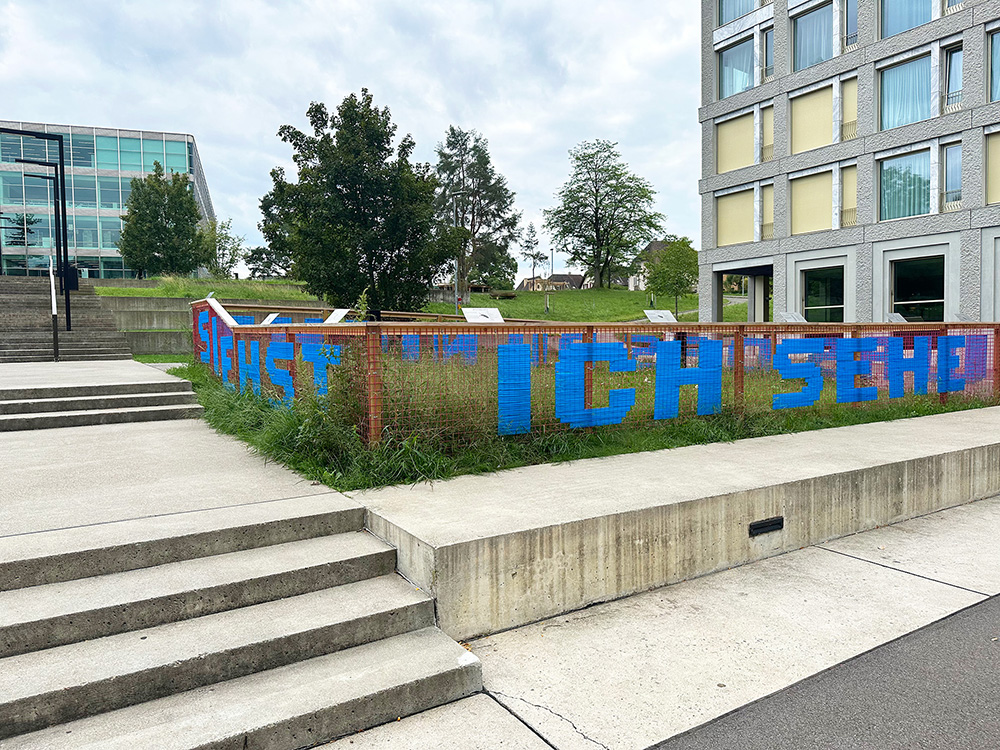
Design intervention by HGK students on the FHNW campus in Brugg-Windisch: project “Der Auftakt” (2023), presentation of discreet but ecologically important small animals in a zoo format.
RECONFIGURED INFRASTRUCTURES
How can objects, furniture and infrastructure be repurposed or recontextualized to help promote biodiversity?
Situation and ecological challenge
City infrastructures and public furniture systems for parks and streets are designed to support people during leisure activities, while waiting for public transport, with illumination at nighttime, or similar. Unfortunately, the more-than-human actors of those habitats are usually not incorporated in the planning and design approaches. The infrastructures and public furniture should be improved with regard to their biodiversity potential and to better meet the needs of non-human life forms.
Key Concepts
The aim of this teaching unit, which was carried out with students from the Basel Academy of Art and Design FHNW (HGK), was not to design new urban, bio-inclusive furniture, but to examine and adapt existing installations. Through minimal interventions, activism and visualizations, the aim was to draw attention to grievances and present proposals for redesign, expansion or reconfiguration. The appearance of other life forms should also lead to greater human understanding and empathy for their perspectives and needs. In addition to the actions and prototypes, the students were asked to make suggestions on how future infrastructure should integrate biodiversity functions by default.
A more detailed description of the carried out actions, implemented prototypes and the teaching units are presented in the publication 'Mitwelten. Media-ecological Design Strategies for Improving Peri Urban Biodiversity'. (Coming soon!)
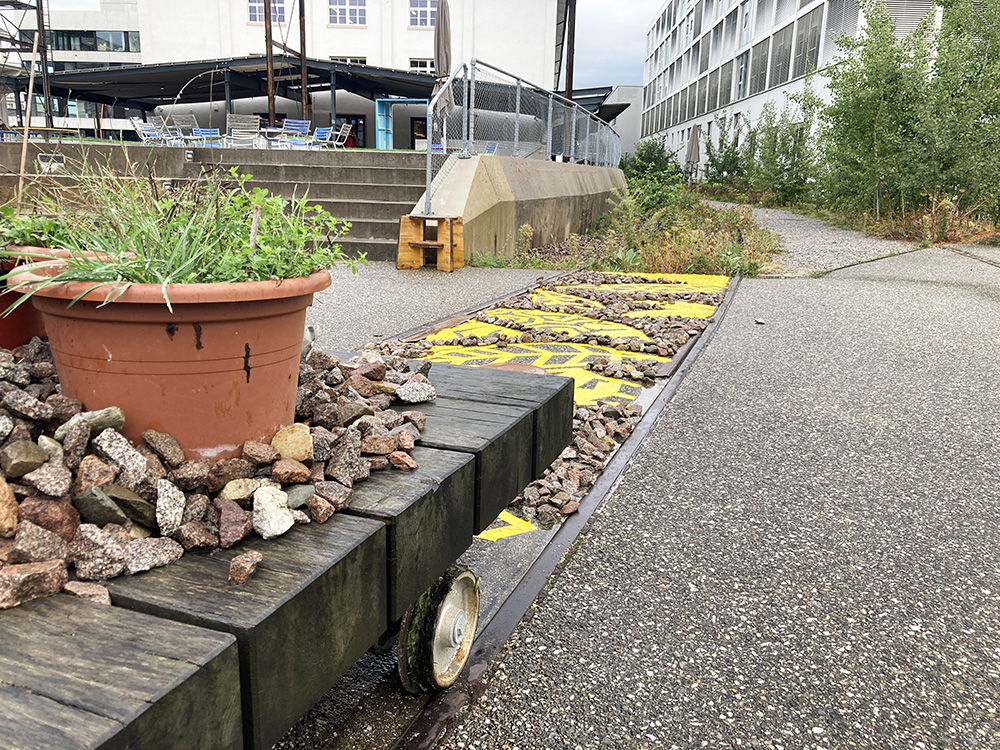
Design intervention by students on the HGK campus: “Networking Corridor” (2023), call for the renaturation of paved railroad tracks.
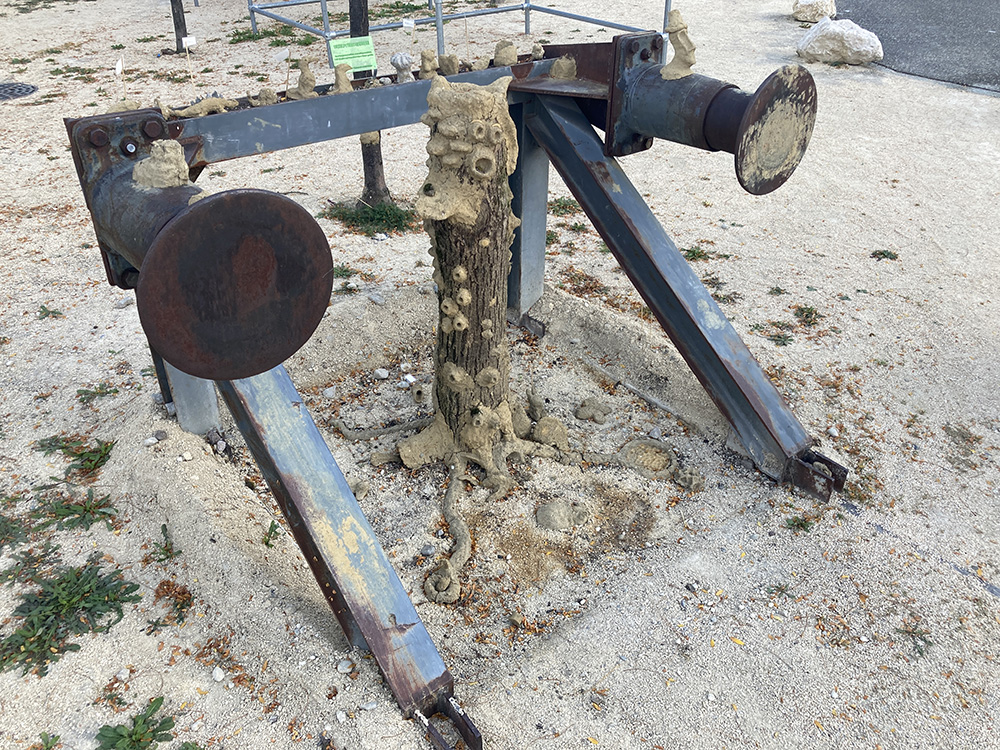
Design intervention by students on the HGK campus: “Seed Sculpture” (2023), art as an ephemeral biodiversity promoter.
STEPPING STONE HABITATS
How should modular stepping stone biotopes be designed so that they can be attached to existing infrastructure and contribute to biodiversity connectivity?
Situation and ecological challenge
Based on international agreements (UNO, COP, etc.), a national action plan has been developed that aims to ensure that Switzerland has a functioning ecological infrastructure and a range of environmental measures in place to preserve the diversity of species and habitats by 2040. In addition to promoting a sufficient number of ecologically valuable habitats, their connectivity is also of central importance, especially for genetic diversity.
Key Concepts
Wildlife-friendly corridors are usually made up of hedgerows and wildflower strips, with the addition of piles of branches and stones to provide sufficient shelter and food. In densely populated, sealed urban areas, however, they can hardly be laid out continuously, which is why the establishment of regularly occurring stepping stone habitats to bridge the gap between one natural habitat and the next can help (especially for birds, insects and plant seeds). In the context of the Mitwelten research project, concrete solutions for the ecological principle of Stepping Stone Habitats in peri-urban areas were examined.
A more detailed description of the concepts and implemented prototypes are presented in the publication 'Mitwelten. Media-ecological Design Strategies for Improving Peri Urban Biodiversity'. (Coming soon!)
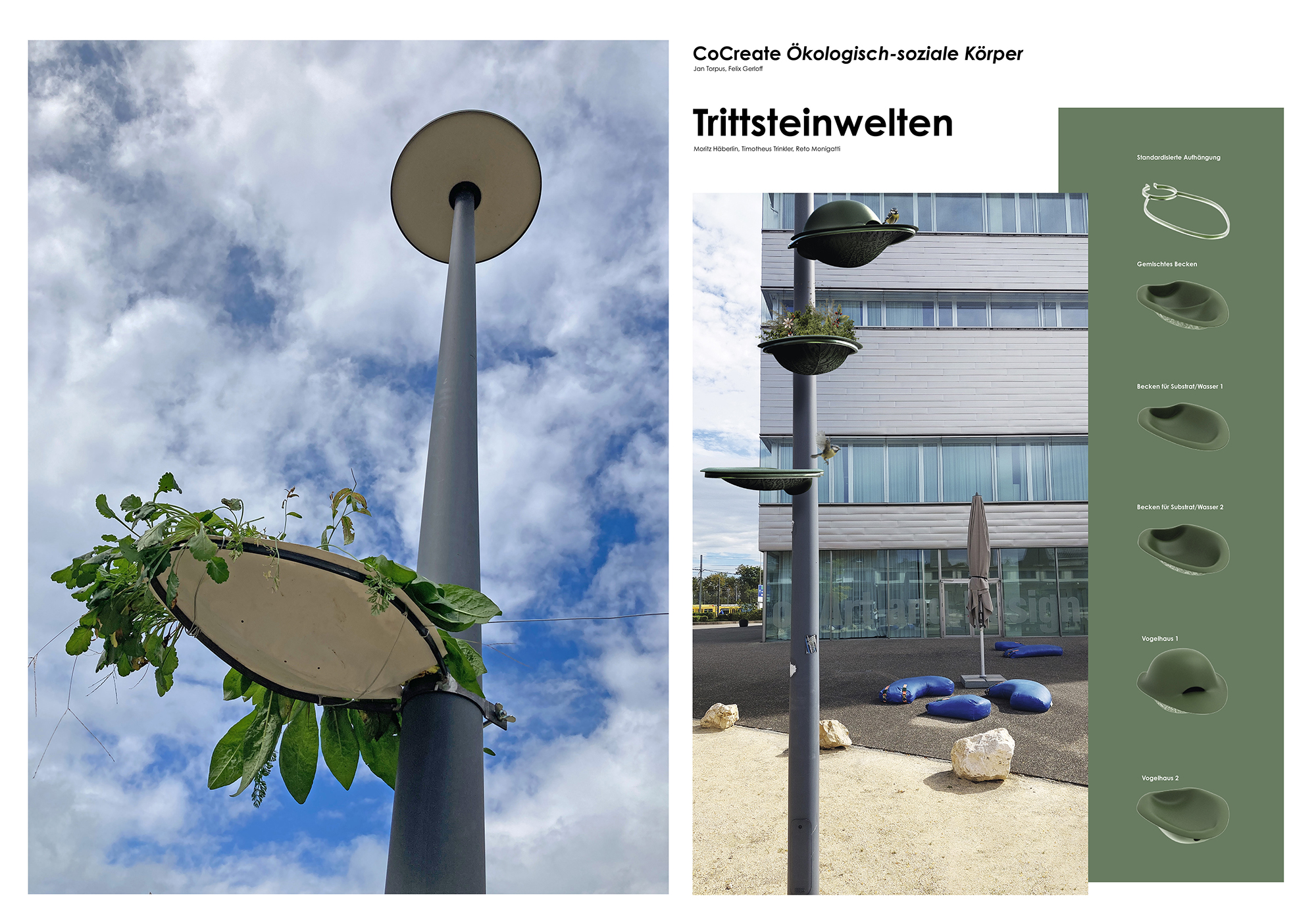
Design intervention by students on the HGK Campus: “Trittsteinwelten” (2023), modular system for the biodiversity-promoting expansion of existing infrastructures.
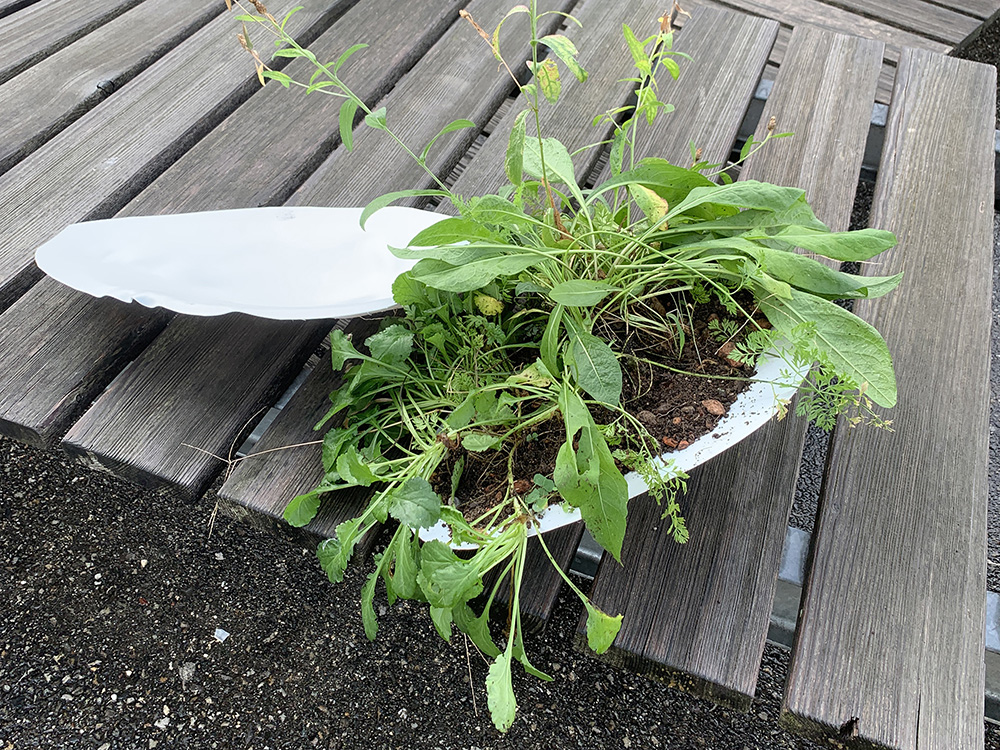
Design intervention by students on the HGK campus (2023): plant bed unit of the modular “Trittsteinwelten” system.